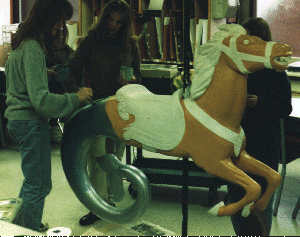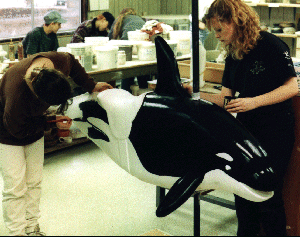

Filling
Before using a filler, consider using wood, it is stronger and will last longer, check the section on the "graben" for deep fills and fixes. Otherwise, do what ever filling might be necessary, if something is big and really needs a lot of shaping, use a body building type filler. Narrow wooden wedges work well in cracks. Remember, wherever you can use wood to fill do it.
There are many types of wood fillers, the type for exterior use is best, they are usually better quality. The solvent based or two component fillers are only necessary for unusual jobs where a regular filler won't do the trick, these usually dry quicker and are more toxic.
Primer paint
Use an oil based exterior wood primer for painting the raw wood. The color coats can done in latex gloss or semi-gloss enamels or alkyd oil base enamels. Be sure primer is not too thick, one or two thin coats are better. This will raise the grain when dry and require a light sanding to remove the stiff wood hairs. It's usually good to give it another touch-up coat afterward.
When putting on the primer (or the final color paint itself for that matter), turn the animal upside down and paint everything you can see from the underneath first, when done, put it up-right, preferably on a stand, and finish the job. Be sure to apply paint thinly, avoiding heavy streaking or sheeting across the grain of the wood. Try to paint with the grain. Some additional filling of small holes and abnormalities may occur after this first primer coat. Fillers must be primered after they are put in otherwise you will have a dull spot on your final color coat.
Final sanding
When all of the primer is bone dry, sand off all the fuzzy little burrs and easily visible hard edges or corners (not easily viewed when wood is raw). Use a 100 or 120 grit sandpaper, a little bit of touch-up primer might be necessary too.
Color coats (the fun you have been waiting for!)
In order to have a nice pallet of colors use an old biscuit tin to mix little batches of paint, you can carry colors from one well to the next, changing them by adding the can colors or universal colorants (i.e. burnt sienna, raw umber, yellow ochre, lamp black, etc.) along the way. Always mix colors in small batches and increase their size and color combinations gradually, don't forget this. When you are mixing colors it's easy to get carried away and make a huge batch of something you use little or not at all. Going slowly and in very small batches until you have your combination figured out is the way to avoid this waste.
The basic colors to have on hand in large quantity are red, yellow, blue, white and black, many colors can be made from these. To make this process more streamlined it is also good to have a green, a brown, and a few other hard to make colors you like on hand, bought ready mixed in the can. Also, there are special opalescent colors which are wonderful to use on carousel animals, check the supplier list.


Start painting the large areas first, gradually working
your way to smaller and smaller areas.